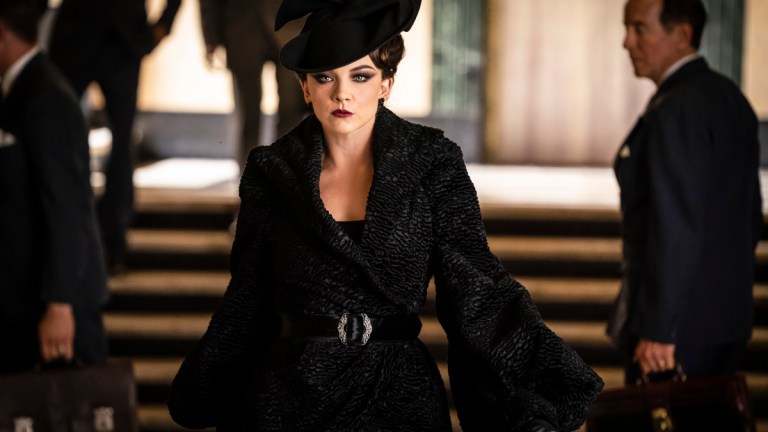Penny Dreadful: City of Angels Episode 1 Review – Santa Muerte
Penny Dreadful: City of Angels scorches the earth of the old series as "Santa Muerte" stakes its own territory in the streets of Los Angeles.

This Penny Dreadful: City of Angels review contains spoilers.
Penny Dreadful: City of Angels Episode 1
“There will come a time when the world is ready for me, when nation will battle nation, when race will devour race, when brother will kill brother until not a soul is left. Are you ready?” we are asked at the very beginning of Penny Dreadful: City of Angels premiere episode, “Santa Muerte.” And we are. It’s only been four years since Eva Green’s Vanessa Ives put a stake in the heart of her most gothic of nemeses, Count Dracula, and Dr. Frankenstein’s creature set out to chill in the arctic. The new incarnation opens in the bright heat of sunshine.
As if there wasn’t enough brightness, the first supernatural entity we encounter is dressed in white with a bright golden headpiece, and the title character of the episode. Santa Muerte (Lorenza Izzo) carries the souls of the newly dead to wherever it is she takes them. But it is her sister who brings the heat, setting the series ablaze and ultimately going on to be half the cast tonight: Magda, played by Natalie Dormer from the Showtime series The Tudors and HBO’s Game of Thrones. She set the spark in motion which burns off any remnants of the dark gothic original series.
City of Angels is not going to be a continuation of the original series at all. This is a new Penny Dreadful. The last of the penny dreadfuls, the short and cheaply produced stories the series is named for, was published in 1896. City of Angels skips the dime novel and goes straight for the pulp. Magda, the supernatural shape-shifting agent of chaos, dresses in black in her natural form, as a pure femme fatale. She puts herself in the middle of the biggest villains of the time. Racist cops, crooked politicians and Nazis. The monsters here are men.
“All mankind needs to be the monster he truly is, is being told he can,” Magda says in the very opening sequence. She’s only out to make their dreams come true, and prove the point to her sister. The setup appears to be that World War II happened all because of a sibling rivalry. All of mankind was at stake at the end of the original series, and that was just because someone let their portrait dry. Here it looks like the stakes are just as high.
The main hero, Tiago Vega (Daniel Zovatto), is introduced in the dark. His family is throwing an evening party celebrating his appointment as the LAPD’s first Mexican-American detective. His gold shield almost matches the crown El Muerte wore when she spared his soul and left her mark. Tiago’s mother Maria (Adriana Barraza) is a devout follower of the dark Saint but the evening party is set to late ‘30s dance music and establishes the family dynamic early. Tiago’s brother Raul (Adam Rodriguez) thinks being a cop is selling out and the mother stands in the middle.
Penny Dreadful: City Angels is set in Los Angeles in 1938, and the murder at the center looks like a grotesque satire of the Black Dahlia murders in the 40s, with a touch of Joker. The “butchery by the river,” as Detective Lewis Michener (Nathan Lane) calls it, is four naked bodies, ritualistically arranged foot to foot. Their faces are carved into masks of deaths with gemstones adorning them like some “Hollywood Max Factor bullshit,” Michener observes, and it appears the victims had their heart cut out. The scene is caught in the unyielding glare of broad daylight.
Lane completely catches the hard-boiled detective of the noir classics which would come after World War II. The patter comes comfortably off his tongue and he still bites back on his words when his character, a veteran homicide cop, is surprised by the scene under the highway. Tiago visibly fights down an urge to throw up and also shoots his new, and senior, partner a look of daggers when he throws casual racial epithets into criminal analyses. Whoever killed the four people left a message in blood on the concrete underpass, a heart for a heart, it basically says in Spanish.
Maria Vega works for a wealthy German doctor now living in America named Peter Craft, played by Rory Kinnear, who is the only returnee from the original series. He seems a nice enough guy, he takes taunts from his sons good-naturedly and his wife apparently has a drinking problem, but he would still offer any free medical help to his cleaning lady’s family. He’s probably most especially pleasant during his lunch hours, when he’s free to relax and slip into something more comfortable, the uniform of the German-American Bun. He’s a Nazi. Dr. Craft listens to pronunciation tapes in his car so he can say things to his patients like “childhood respiratory distress” without sounding like Elmer Fudd. He is treating other German born Americans, mostly children, and one of the mothers is very familiar.
Mrs. Elsa Branson is the first time we see Natalie Dormer in one of Magda’s other guises. She is a loving mother who is very, very close to her ill son. They are very attached. So much so it takes a pretty cool special effect to discern where mother ends and child begins. Magda’s multi-character introduction is cemented when we find her also at the side of Councilman Charlton Townsend, who wants to build California’s first freeway over a thriving Mexican neighborhood. He sees himself as a budding Mussolini or, dare I say, a little Hitler.
Detective Michener is on this case as well. In his spare time, he is a Nazi hunter and he’s already on the trail of the Third Reich’s march down Hollywood Boulevard, but he doesn’t know he’s standing at the crossroads when it happens. The crossroads is usually where blues musicians go to sell their soul to the devil for killer fingers. Here it is where the opening prophecy is being fulfilled, when brother kills brother and races devour face. Of course it might just be because Maria wakes Santa Muerte from her slumber to shed tears for people she pretends not to care for.
The scenes with Santa Muerte are the most horror-genre friendly, but Penny Dreadful: City of Angels finds its evil most frightening in the mundane episodes of mob violence. Magda’s closing whispers draw first blood and last as the ending scene of the first episode bring the fights to the streets. The new series sets itself apart completely and promises a whole new world of terrors. The local race riot promises a larger battle and Magda comes into her enthralling own as she moves the pieces across the chessboard like expendable pawns.


